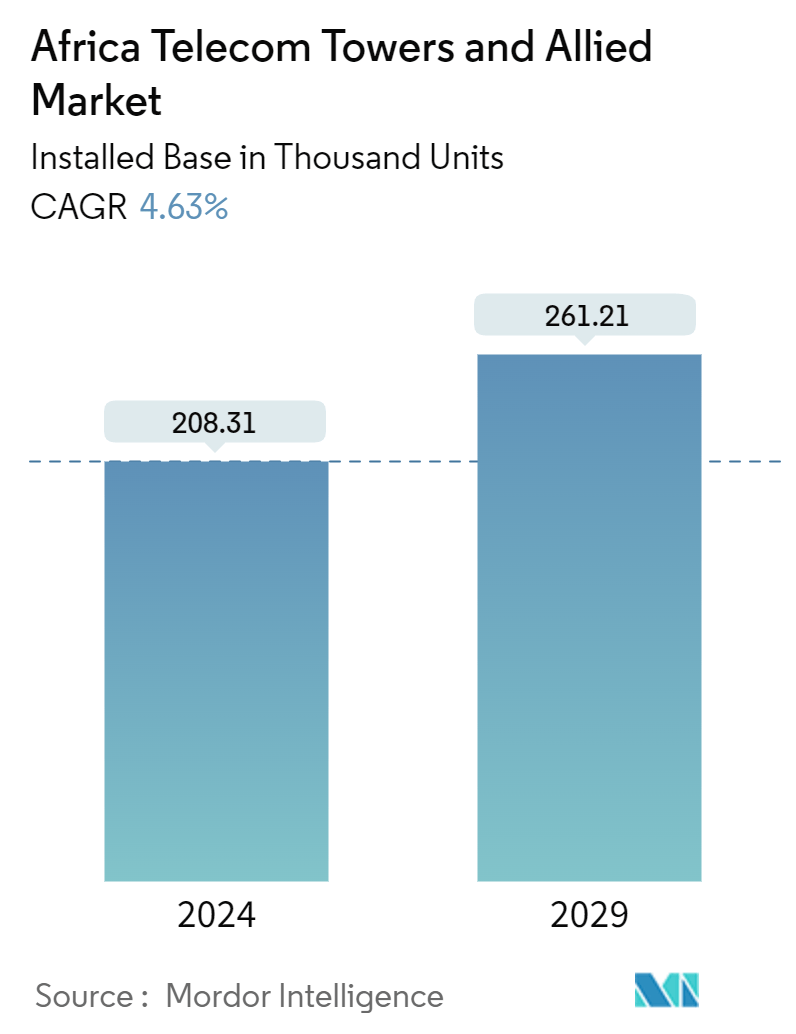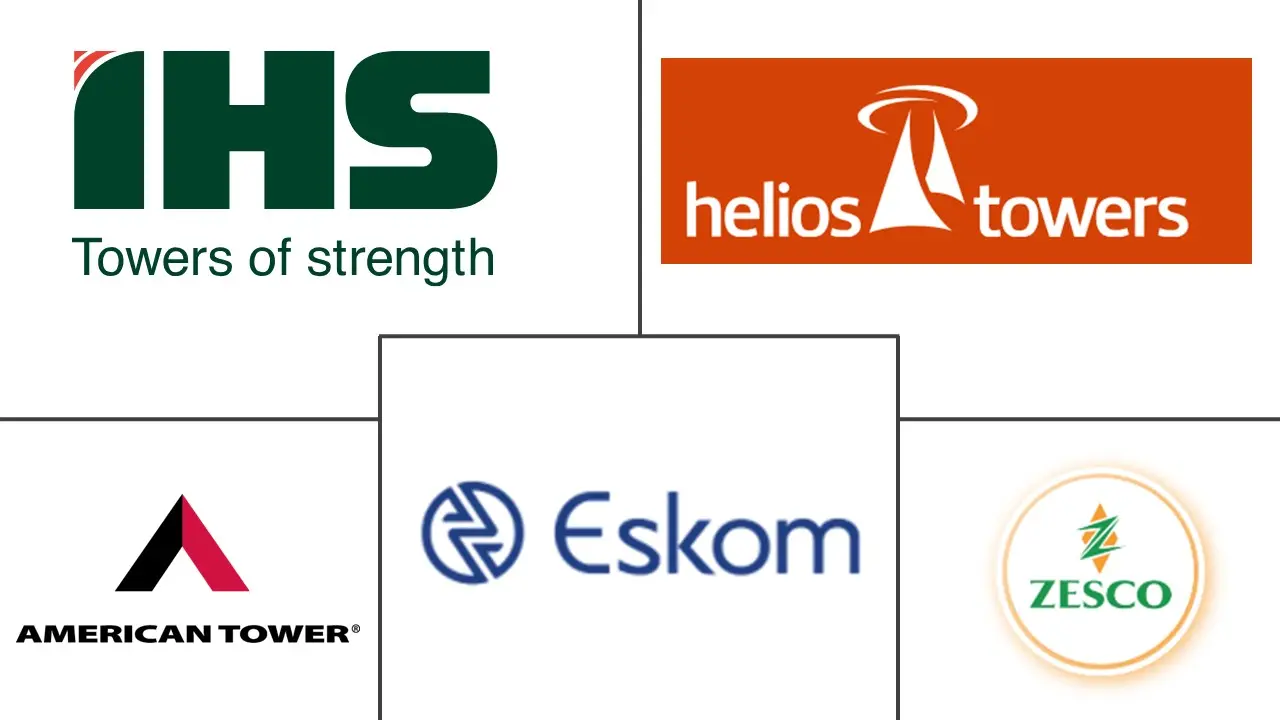Market Size of Africa Telecom Towers And Allied Industry

| Study Period | 2019 - 2029 |
| Base Year For Estimation | 2023 |
| Forecast Data Period | 2024 - 2029 |
| Historical Data Period | 2019 - 2022 |
| CAGR (2024 - 2029) | 4.63 % |
| Market Concentration | Medium |
Major Players
*Disclaimer: Major Players sorted in no particular order |
Africa Telecom Towers Market Analysis
The Africa Telecom Towers And Allied Market size in terms of installed base is expected to grow from 208.31 Thousand units in 2024 to 261.21 Thousand units by 2029, at a CAGR of 4.63% during the forecast period (2024-2029).
- The telecom tower industry has drastically evolved over the past decade. The core towerco proposition and business models have been successfully adapted to match the demands of new markets in Africa. Many towercos are anticipated to hunker down in their core building business over the forecast period, buying and leasing vertical real estate, and such towercos may still see plenty of 5G antenna overlaid onto their towers.
- As per the Nigerian Communications Commission, as of January 2021, the number of third and fourth-generation telecom towers deployed in Nigeria has grown by 73.2%. Also, global tower companies are expanding their presence in the region, through strategic collaborations, due to the growing number of opportunities presented.
- The emergence of KaiOS and its partnerships with operators across Africa is helping overcome the affordability barrier for low-income users. The free resources offered, such as the 'Life' app, also help new users develop digital skills and understand how the internet can be relevant. Such initiatives are expected to boost internet penetration in these countries significantly.
- Several initiatives by telecom operators and other organizations, especially in low and middle-income countries, are expected to spur growth in the rural areas as the residents of these areas gain increased access to internet connectivity.
- Furthermore, with businesses going mobile and adopting new concepts, like BYOD, to increase employee interaction and ease of use, it has become essential to provide a high-speed and quality network. The organizations have been looking forward to adopting BYOD aggressively in their operations, fueling the market growth over the forecast period. Furthermore, development in cloud-based services for mobile users and the roll-out of 4G LTE services worldwide have increased the investment into networks by carriers, which drives the demand for telecom towers.
- The increasing emphasis on improving internet connectivity to rural areas is one of the major factors stimulating the deployment and improvisation of the telecom infrastructure in these areas, thereby aiding the market's growth. Smartphone penetration, raising awareness, increasing penetration of digital technologies, and investments from several organizations and governments have been increasing the adoption of internet connections in the region.
Africa Telecom Towers Industry Segmentation
The Telecom Towers market study tracks the installed base of telecom towers across Africa. The study provides a market breakdown by fuel type, ownership, and region. Market dynamics, market attractiveness, and key developments are covered as part of the study. The scope of the study has been segmented based on the ownership (operator-owned, joint venture, private-owned, and MNO captive) and fuel type (renewable and non-renewable) across Africa.
The Telecom Power market study tracks the revenue opportunity for power suppliers in Africa. : The scope of the study has been segmented based on utility billing (generation and distribution) and generation source (renewable, hydro, and other generation sources) across Africa.
The Africa Telecom Towers and Allied Market is segmented by Telecom Tower Market (ownership (operator owned, joint venture, private owned, MNO captive), by fuel type (renewable, non-renewable), by country (Algeria, Nigeria, South Africa, Tanzania, Morocco, Rest of Africa)), by Africa power market (type [generation, distribution], by generation source (renewable, hydro), by country (installed capacity in GW) (Algeria, Nigeria, South Africa, Tanzania, Morocco, Rest of Africa)). The market sizes and forecasts are provided in terms of Units and Electricity Installed Capacity (MW) for Telecom Tower segments and Power Segments, respectively.
| By Ownership | |
| Operator Owned | |
| Joint Venture | |
| Private Owned | |
| MNO Captive |
| By Fuel Type | |
| Renewable | |
| Non-Renewable |
| By Country | |
| Algeria | |
| Nigeria | |
| South Africa | |
| Tanzania | |
| Morocco |
Africa Telecom Towers And Allied Market Size Summary
The African telecom towers market is poised for significant growth, driven by the increasing demand for enhanced connectivity and the expansion of mobile networks across the continent. The industry has undergone substantial transformation over the past decade, with tower companies adapting their business models to meet the unique demands of African markets. This evolution is supported by the strategic expansion of global tower companies in the region, which are leveraging partnerships to capitalize on emerging opportunities. The proliferation of digital technologies, coupled with initiatives aimed at improving internet access in rural areas, is expected to further stimulate market growth. The adoption of cloud-based services and the rollout of advanced network technologies, such as 4G LTE and 5G, are also contributing to the rising demand for telecom towers, as businesses and consumers alike seek faster and more reliable connectivity.
The market landscape is characterized by a mix of privately-owned and independent tower companies, which play a crucial role in supporting mobile network operators (MNOs) by providing the necessary infrastructure to expand their services. These companies are increasingly acquiring tower portfolios from MNOs, allowing operators to focus on their core business while reinvesting capital into network enhancements. The growth of smartphone penetration and digital literacy initiatives is further driving the demand for telecom infrastructure, particularly in underserved regions. South Africa, in particular, is witnessing a surge in telecom tower investments, driven by government efforts to boost broadband adoption and the rapid rollout of 5G services. The competitive landscape is dominated by key players such as IHS Towers, Helios Towers, and American Tower Corporation, who are actively pursuing strategic alliances and investments to strengthen their market position and expand their footprint across the continent.
Africa Telecom Towers And Allied Market Size - Table of Contents
-
1. MARKET INSIGHTS
-
1.1 Market Overview
-
1.2 Assessment of the Impact of COVID-19 on the Industry
-
1.3 Analysis of Key Regulatory Reforms
-
-
2. MARKET SEGMENTATION
-
2.1 By Ownership
-
2.1.1 Operator Owned
-
2.1.2 Joint Venture
-
2.1.3 Private Owned
-
2.1.4 MNO Captive
-
-
2.2 By Fuel Type
-
2.2.1 Renewable
-
2.2.2 Non-Renewable
-
-
2.3 By Country
-
2.3.1 Algeria
-
2.3.2 Nigeria
-
2.3.3 South Africa
-
2.3.4 Tanzania
-
2.3.5 Morocco
-
-
Africa Telecom Towers And Allied Market Size FAQs
How big is the Africa Telecom Towers And Allied Market?
The Africa Telecom Towers And Allied Market size is expected to reach 208.31 thousand units in 2024 and grow at a CAGR of 4.63% to reach 261.21 thousand units by 2029.
What is the current Africa Telecom Towers And Allied Market size?
In 2024, the Africa Telecom Towers And Allied Market size is expected to reach 208.31 thousand units.

